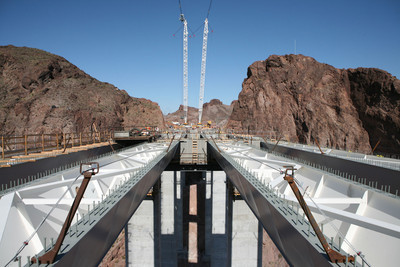Monumental work at full speed

It was the hard hat on my head that made no sense to me.
I was standing on the edge of the Nevada approach span of the Hoover Dam Bypass bridge and in front of me was an 890-foot drop to the Colorado River.
The water looked dark, cold and far away.
The plank I was standing on creaked and shifted under my weight. At that point, I wasn’t sure whether the clean underwear I had on was going to stay that way.
I couldn’t help but think of that scene in “Butch Cassidy and the Sundance Kid,” when Robert Redford and Paul Newman, or more likely their stunt doubles, take a running jump into some wild river from a cliff.
Maybe a life preserver was more apropos than a helmet.
All I knew for sure was that if the bridge gave way, the hard hat wasn’t going to help me at all.
I was on a tour of the construction site with U.S. Secretary of Transportation Mary Peters, so I was pretty certain it was safe.
The bypass bridge project is finally back up to full speed after a pair of crane towers collapsed, causing a 17-month delay. It’s not every day that a Cabinet member visits a job site. And because Peters was there, I, along with a fellow reporter and a photographer, was given access to the site that I probably wouldn’t have had otherwise.
It’s also not every day that a Cabinet member calls me by my first name. It happened at least five times on Wednesday — I blush easily.
“Francis,” Peters said, “you’re standing on the edge of history.”
I smiled politely, but didn’t fully appreciate the gravity of the moment.
You see, my mind was too busy trying to decide whether the General Lee from “The Dukes of Hazard” could make the jump to the Arizona side.
Jokes aside, Peters wasn’t overstating the project’s grandeur.
When completed in 2010, the Mike O’Callaghan-Pat Tillman Memorial Bridge will be the longest concrete arch bridge in the Western Hemisphere and probably the one with the longest name.
It will span about 1,000 feet over the rocks and water below.
And there’s a good chance it will be around for a long time, considering the longevity of arch bridges. The Arkadiko bridge in Greece was built around 1300 B.C. It’s mostly made of boulders and probably only spans about 20 feet, but it’s still used by pedestrians today.
It was the Romans, sometime around 100 A.D., who were the first to make arch bridges out of concrete, some of which are still standing.
It’s funny how old bridge-building techniques never go out of style.
As I stood at the edge of this engineering marvel, I also stared at the Hoover Dam — not too shabby an engineering feat itself.
The view of the Hoover Dam from the bypass bridge is iconic. There will be a walkway on the bridge to allow folks to snap photos.
Drivers, however, will not be able to see the Hoover Dam as they drive over the bridge.
That’s probably a good thing.
With more than 17,000 cars and trucks expected to use the new bridge on a daily basis when it opens, I’m pretty sure not being able to look over the edge will prevent some fender-benders. Especially considering how long I stood distracted, trying figure out if the hard hat would even stay on my head during the fall.
If you have a question, tip or tirade, call the Road Warrior at 387-2904, or e-mail him at roadwarrior@reviewjournal.com or fmccabe@reviewjournal.com. Please include your phone number.